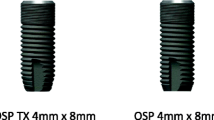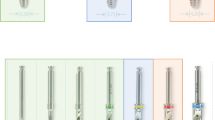Abstract
Primary stability has a major impact on the long-term success of dental implants. The aim of this study was to investigate the correlation of resonance frequency analysis (RFA) and insertion torque of self-tapping and non-self-tapping implants and their respective differences in primary stability. A group of 263 patients were treated with a total of 602 conically formed dental implants: 408 non-self-tapping Ankylos® and 194 self-tapping Camlog®. The maximum insertion torque during implant placement was recorded. Resonance frequency, measured as the implant stability quotient (ISQ), was assessed once immediately after insertion and twice 3 months later. Torque values of the non-self-tapping implants were significantly higher than those in the self-tapping group (p = 0.023). RFA did not show differences between the 2 groups (p = 0.956), but a correlation between ISQ values after implantation and 3 months after implant placement was measured (r = 0.712). Within the implant systems, no correlation between insertion torque and resonance frequency values could be determined (r = 0.305). Our study indicates that the ISQ values obtained from different implant systems are not comparable. The RFA does not appear suitable for the evaluation of implant stability when used as a single method. Higher insertion torque of the non-self-tapping implants appeared to confirm higher clinical primary stability.








Similar content being viewed by others
References
Akca K, Akkocaoglu M, Comert A, Tekdemir I, Cehreli MC (2005) Human ex vivo bone tissue strains around immediately loaded implants supporting maxillary overdentures. Clin Oral Implants Res 16(6):715–722
Akkocaoglu M, Uysal S, Tekdemir I, Akca K, Cehreli MC (2005) Implant design and intraosseous stability of immediately placed implants: a human cadaver study. Clin Oral Implants Res 16(2):202–209
Al-Nawas B, Brahm R, Grötz KA (2002) Resonanzfrequenzanalyse zur non-invasiven Analyse der Primärstabilität enossaler Implantate in vivo. Z Zahnärztl Implantol 18:142–148
Bähr W (1992) Comparison of torque measurements between cortical screws and emergency replacement screws in the cadaver mandible. J Oral Maxillofac Surg 50(1):46–49
Balleri P, Cozzolino A, Ghelli L, Momicchioli G, Varriale A (2002) Stability measurements of osseointegrated implants using Osstell in partially edentulous jaws after 1 year of loading: a pilot study. Clin Implant Dent Relat Res 4(3):128–132
Beer A, Gahleitner A, Holm A, Tschabitscher M, Homolka P (2003) Correlation of insertion torques with bone mineral density from dental quantitative CT in the mandible. Clin Oral Implants Res 14(5):616–620
Becker W, Sennerby L, Bedrossian E, Becker BE, Lucchini JP (2005) Implant stability measurements for implants placed at the time of extraction: a cohort, prospective clinical trial. J Periodontol 76(3):391–397
Bischof M, Nedir R, Szmukler-Moncler S, Bernard JP, Samson J (2004) Implant stability measurement of delayed and immediately loaded implants during healing. Clin Oral Implants Res 15(5):529–539
Büchter A, Kleinheinz J, Joos U, Meyer U (2003) Primary implant stability with different bone surgery techniques. An in vitro study of the mandible of the minipig. Mund Kiefer Gesichtschir 7(6):351–355
da Cunha HA, Francischone CE, Filho HN, de Oliveira RC (2004) A comparison between cutting torque and resonance frequency in the assessment of primary stability and final torque capacity of standard and TiUnite single-tooth implants under immediate loading. Int J Oral Maxillofac Implants 19(4):578–585
Ersanli S, Karabuda C, Beck F, Leblebicioglu B (2005) Resonance frequency analysis of one-stage dental implant stability during the osseointegration period. J Periodontol 76(7):1066–1071
Friberg B, Jemt T, Lekholm U (1991) Early failures in 4,641 consecutively placed Brånemark dental implants: a study from stage 1 surgery to the connection of completed protheses. Int J Oral Maxillofac Implants 6(2):142–146
Friberg B, Sennerby L, Meredith N, Lekholm U (1999) A comparison between cutting torque and resonance frequency measurements of maxillary implants. A 20-month clinical study. Int J Oral Maxillofac Surg 28(4):297–303
Friberg B, Sennerby L, Roos J, Johansson P, Strid CG, Lekholm U (1995) Evaluation of bone density using cutting resistance and microradiography: an in vitro study in pig ribs. Clin Oral Implants Res 6(3):164–171
Friberg B, Sennerby L, Roos J, Lekholm U (1995) Identification of bone quality in conjunction with insertion of titanium implants. A pilot study in jaw autopsy specimens. Clin Oral Implants Res 6(4):213–219
Glauser R, Sennerby L, Meredith N, Ree A, Lundgren A, Gottlow J, Hammerle CH (2004) Resonance frequency analysis of implants subjected to immediate or early functional occlusal loading. Successful vs. failing implants. Clin Oral Implants Res 15(4):428–434
Homolka P, Beer A, Birkfellner W, Nowotny R, Gahleitner A, Tschabitscher M, Bergmann H (2002) Bone mineral density measurement with dental quantitative CT prior to dental implant placement in cadaver mandibles: pilot study. Radiology 224(1):247–252
Horwitz J, Zuabi O, Peled M (2003) Resonance frequency analysis in immediate loading of dental implants. Refuat Hapeh Vehashinayim 20(3):80–88, 104
Huang HM, Chiu CL, Yeh CY, Lee SY (2003) Factors influencing the resonance frequency of dental implants. J Oral Maxillofac Surg 61(10):1184–1188
Huang HM, Lee SY, Yeh CY, Lin CT (2002) Resonance frequency assessment of dental implant stability with various bone qualities: a numerical approach. Clin Oral Implants Res 13(1):65–74
Ivanoff CJ, Sennerby L, Lekholm U (1996) Influence of mono- and bicortical anchorage on the integration of titanium implants. A study in the rabbit tibia. Int J Oral Maxillofac Surg 25(3):229–235
Johansson P, Strid KG (1994) Assessment of bone quality from cutting resistance during implant surgery. Int J Oral Maxillofac Implants 9:279–288
Lachmann S, Jäger B, Axmann D, Gomez-Roman G, Groten M, Weber H (2006) Resonance frequency analysis and damping capacity assessment. Part 1: an in vitro study on measurement reliability and a method of comparison in the determination of primary dental implant stability. Clin Oral Implants Res 17(1):75–79
Lachmann S, Laval JY, Jäger B, Axmann D, Gomez-Roman G, Groten M, Weber H (2006) Resonance frequency analysis and damping capacity assessment. Part 2: peri-implant bone loss follow-up. An in vitro study with the Periotest and Osstell instruments. Clin Oral Implants Res 17(1):80–84
Lekholm U, Zarb GA (1985) Patient selection and preparation. In: Brånemark PI, Zarb GA, Albrektson T (eds) Tissue-integrated protheses: osseointegration in clinical dentistry. Quintessence, Chicago, pp 199–209
Meredith N (1998) Assessment of implant stability as a prognostic determinant. Int J Prosthodont 11(5):491–501
Meredith N, Alleyne D, Cawley P (1996) Quantitative determination of the stability of the implant–tissue interface using resonance frequency analysis. Clin Oral Implants Res 7(3):261–267
Miyamoto I, Tsuboi Y, Wada E, Suwa H, Iizuka T (2005) Influence of cortical bone thickness and implant length on implant stability at the time of surgery—clinical, prospective, biomechanical, and imaging study. Bone 37(6):776–780
Nedir R, Bischof M, Szmukler-Moncler S, Bernard JP, Samson J (2004) Predicting osseointegration by means of implant primary stability. Clin Oral Implants Res 15(5):520–528
Nentwig GH (2004) Ankylos implant system: concept and clinical application. J Oral Implantol 30(3):171–177
Neugebauer J, Traini T, Thams U, Piattelli A, Zoller JE (2006) Peri-implant bone organization under immediate loading state. Circularly polarized light analyses: a minipig study. J Periodontol 77(2):152–160
Ostman PO, Hellman M, Sennerby L (2005) Direct implant loading in the edentulous maxilla using a bone density-adapted surgical protocol and primary implant stability criteria for inclusion. Clin Implant Dent Relat Res 7(Suppl 1):S60–S69
Ostman PO, Hellman M, Wendelhag I, Sennerby L (2006) Resonance frequency analysis measurements of implants at placement surgery. Int J Prosthodont 19(1):77–83, discussion 84
O’Sullivan D, Sennerby L, Meredith N (2000) Measurements comparing the initial stability of five designs of dental implants: a human cadaver study. Clin Implant Dent Relat Res 2(2):85–92
O’Sullivan D, Sennerby L, Meredith N (2004) Influence of implant taper on the primary and secondary stability of osseointegrated titanium implants. Clin Oral Implants Res 15(4):474–480
Ottoni JM, Oliveira ZF, Mansini R, Cabral AM (2005) Correlation between placement torque and survival of single-tooth implants. Int J Oral Maxillofac Implants 20(5):769–776
Sakoh J, Wahlmann U, Stender E, Nat R, Al-Nawas B, Wagner W (2006) Primary stability of a conical implant and a hybrid, cylindric screw-type implant in vitro. Int J Oral Maxillofac Implants 4(21):560–566
Schmid MR, Schiel HJ, Lambrecht JT (2002) Torque of endosseous dental screw type implants. Schweiz Monatsschr Zahnmed 112(8):804–813
Schroeder A, Stich H, Straumann F, Sutter F (1978) Über die Anlagerung von Osteozement an einen belasteten Implantatkörper. Schweiz Monatsschr Zahnmed 88(10):1051–1058
Traini T, Assenza B, San Roman F, Thams U, Caputi S, Piattelli A (2006) Bone microvascular pattern around loaded dental implants in a canine model. Clin Oral Investig 10(2):151–156
Trisi P, Rao W (1999) Bone classification: clinical-histomorphometric comparison. Clin Oral Implants Res 10(1):1–7
Turkyilmaz I, Tozum TF, Tumer C, Ozbek EN (2006) Assessment of correlation between computerized tomography values of bone, and maximum torque and resonance frequency values at dental implant placement. J Oral Rehabil 33(12):881–888
Zix J, Kessler-Liechti G, Mericske-Stern R (2005) Stability measurements of 1-stage implants in the maxilla by means of resonance frequency analysis: a pilot study. Int J Oral Maxillofac Implants 20(5):747–752
Author information
Authors and Affiliations
Corresponding author
Rights and permissions
About this article
Cite this article
Rabel, A., Köhler, S.G. & Schmidt-Westhausen, A.M. Clinical study on the primary stability of two dental implant systems with resonance frequency analysis. Clin Oral Invest 11, 257–265 (2007). https://doi.org/10.1007/s00784-007-0115-2
Received:
Accepted:
Published:
Issue Date:
DOI: https://doi.org/10.1007/s00784-007-0115-2




